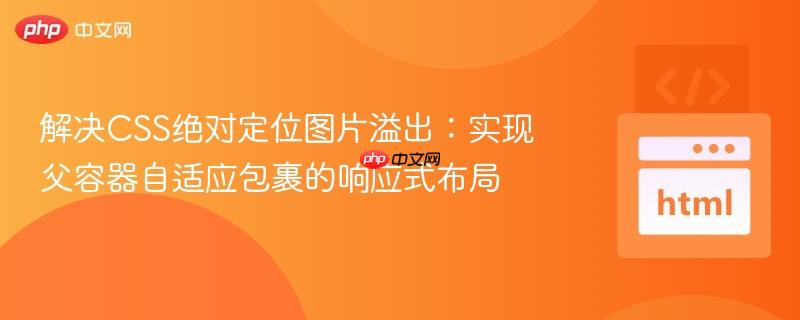
本教程探讨了css中绝对定位元素导致父容器无法自适应包裹的问题,尤其是在响应式图片场景下。我们将深入分析其原因,并提供两种主要解决方案:优先采用现代css布局(如flexbox、grid或浮动)来保持元素在文档流中,以及在绝对定位不可避免时,使用javascript进行动态高度调整,从而实现父容器的正确包裹和响应式行为。
在网页布局中,我们经常需要实现一个头部区域,其中包含背景图片和叠加的文本内容。当背景图片需要根据不同页面动态变化并保持响应式时,一个常见的挑战是,如果图片被设置为 position: absolute,它将脱离文档流,导致其父容器无法感知图片的高度,从而无法正确包裹图片内容,造成溢出。
理解绝对定位与文档流脱离
position: absolute 是CSS中一个强大的定位属性,它允许元素相对于其最近的已定位祖先元素(position 属性非 static 的祖先)进行定位。然而,它的一个核心特性是会将元素从正常的文档流中移除。这意味着:
- 不占用空间: 绝对定位元素不再占据其在文档流中应有的空间。
- 不影响父容器尺寸: 父容器的尺寸计算将忽略其内部的绝对定位子元素。
当一个图片被设置为 position: absolute 且 height: auto 时,尽管图片自身会根据其 width: 100% 和 aspect-ratio 调整高度,但由于它已脱离文档流,其父容器(例如一个 header 或 section 元素)并不会因此而扩展高度来包裹它,从而导致图片溢出父容器。
以下是一个简化的问题代码示例:
立即学习“前端免费学习笔记(深入)”;
Header Title
Header description
@@##@@
#hero {
color: #fff;
height: auto; /* 父容器高度设置为auto,但无法感知绝对定位子元素 */
position: relative; /* 确保子元素可以相对于它定位 */
padding-top: 80px;
padding-bottom: 60px;
z-index: 1;
}
.hero-picture {
position: absolute; /* 关键问题所在:脱离文档流 */
height: auto;
width: 100%;
inset: 0; /* top, right, bottom, left 均为 0 */
z-index: -1; /* 作为背景层 */
}
.hero-picture img {
position: absolute; /* 图片本身也绝对定位 */
height: 100%; /* 填充父picture标签 */
width: 100%;
object-fit: cover; /* 确保图片覆盖整个区域 */
}在这个例子中,#hero 元素虽然设置了 height: auto,但由于 .hero-picture 使用了 position: absolute,#hero 无法根据图片的高度进行自适应。
解决方案一:优化CSS布局(推荐)
解决这个问题的最佳方法是避免对主要内容(如背景图片)使用 position: absolute,而是采用更适合响应式布局的CSS技术,使元素保持在文档流中。
方法一:使用浮动(Floats)
虽然现代布局更倾向于Flexbox或Grid,但浮动仍然是一种将元素保持在文档流中并实现并排布局的有效方法。当图片浮动时,父容器可以通过 overflow: hidden 或 clearfix 技术来包裹浮动元素。
核心思路: 将图片作为常规流中的元素,并让其浮动,文本内容也浮动或通过 margin 调整位置。
#hero {
color: #fff;
/* height: auto; 保持不变 */
position: relative;
padding-top: 80px;
padding-bottom: 60px;
z-index: 1;
overflow: hidden; /* 清除浮动,使父容器包裹浮动子元素 */
}
.hero-picture {
/* 移除 position: absolute */
float: left; /* 或者 float: right */
width: 100%;
height: auto; /* 让图片高度自适应 */
/* z-index: -1; 浮动元素无法直接设置z-index到背景层 */
/* 如果需要背景效果,可能需要将图片作为伪元素背景或使用transform */
}
.hero-picture img {
/* 移除 position: absolute */
display: block; /* 移除图片默认的底部空间 */
width: 100%;
height: auto;
object-fit: cover;
}
.hero-content {
/* 如果hero-content也浮动,需要清除浮动或使用其他布局 */
/* 如果hero-content不浮动,则需要调整margin以避开浮动图片 */
position: relative; /* 确保文本内容在图片之上 */
z-index: 2;
}注意事项: 浮动布局在处理背景层和前景层时相对复杂,因为浮动元素不能像 position: absolute 那样轻易地通过 z-index 沉到背景层。通常,浮动更适合并排布局,而非背景叠加。
方法二:利用Flexbox或Grid布局(现代首选)
Flexbox和Grid是现代CSS布局的强大工具,它们能更好地处理响应式设计,并能轻松地实现父容器自适应包裹子元素。
核心思路: 将父容器设置为Flex容器或Grid容器,将图片和文本内容作为其子项。如果图片作为背景,可以使用CSS background-image 属性,或者将图片作为Flex/Grid项目,并利用其堆叠顺序。
示例:使用Flexbox实现图片背景与内容叠加
如果图片只是作为背景,最简单的方法是直接将图片设置为父容器的 background-image。
#hero {
color: #fff;
height: auto; /* 依然是auto */
position: relative;
padding-top: 80px;
padding-bottom: 60px;
z-index: 1;
/* 将图片设置为背景 */
background-image: url('image-small.webp');
background-position: center;
background-repeat: no-repeat;
background-size: cover; /* 覆盖整个区域 */
/* 伪元素叠加层 */
background-color: #000; /* 默认背景色 */
}
/* 如果需要透明度叠加层,可以为伪元素设置绝对定位 */
#hero::before {
content: '';
position: absolute;
top: 0;
left: 0;
width: 100%;
height: 100%;
background-color: rgba(0, 0, 0, 0.5); /* 黑色半透明叠加 */
z-index: 0; /* 确保在背景图片之上,内容之下 */
}
.hero-content {
position: relative; /* 确保内容在叠加层之上 */
z-index: 2;
display: flex; /* 使用Flexbox布局内容 */
justify-content: flex-start;
align-items: center; /* 垂直居中 */
min-height: 300px; /* 确保内容区域有最小高度,防止图片过小导致内容塌陷 */
/* 其他内容样式 */
}
/* 移除 .hero-picture 和 .hero-picture img 的样式 */
.hero-picture {
display: none; /* 隐藏原始图片,因为已经作为背景 */
}这种方法将图片作为背景处理,父容器的高度将由其内部的文本内容和 padding 决定,同时 background-size: cover 确保图片覆盖整个区域。如果内容较少,父容器可能显得很矮,此时可以给父容器或内容区域设置一个 min-height 来保证视觉效果。
示例:将图片作为Flex项目,并利用 order 或 z-index 调整堆叠
如果必须使用  标签,并且希望它能影响父容器的高度,可以将其作为Flex或Grid项目。
标签,并且希望它能影响父容器的高度,可以将其作为Flex或Grid项目。
#hero {
color: #fff;
height: auto;
position: relative;
padding-top: 80px;
padding-bottom: 60px;
z-index: 1;
display: flex; /* 启用Flexbox */
flex-direction: column; /* 垂直堆叠 */
/* 可以设置一个最小高度 */
min-height: 300px;
}
.hero-picture {
/* 移除 position: absolute */
width: 100%;
/* order: -1; 可以让图片在视觉上排在前面,但仍然在文档流中 */
/* 或者不设置order,让它自然在顶部 */
}
.hero-picture img {
display: block;
width: 100%;
height: auto; /* 关键:让图片高度自适应,并影响父容器高度 */
object-fit: cover;
}
.hero-content {
position: absolute; /* 内容现在需要绝对定位到图片之上 */
top: 0;
left: 0;
width: 100%;
height: 100%; /* 填充整个父容器 */
display: flex;
justify-content: flex-start;
align-items: flex-start; /* 根据需要调整对齐 */
padding-top: 80px;
padding-bottom: 60px;
z-index: 2; /* 确保内容在图片之上 */
}在这种布局中,.hero-picture 作为Flex项目,其高度会影响 #hero 的总高度。而 .hero-content 则需要 position: absolute 来叠加在图片之上。这种方式下,父容器的高度由图片决定,而内容则相对于父容器进行定位。
解决方案二:JavaScript动态调整高度(备选方案)
当 position: absolute 确实是布局的必要条件(例如,为了实现某些复杂的叠加效果,且无法通过CSS伪元素或背景图实现)时,可以使用JavaScript来动态计算并设置父容器的高度。
实现原理:
- 在DOM加载完成后,获取绝对定位图片元素的实际渲染高度。
- 将这个高度值赋给父容器的 height 属性。
- 监听窗口的 resize 事件,当窗口大小改变时,重新执行上述计算和赋值,以保持响应式。
JavaScript 代码示例:
document.addEventListener('DOMContentLoaded', function() {
const heroSection = document.getElementById('hero');
const heroPicture = heroSection.querySelector('.hero-picture');
const heroImage = heroPicture.querySelector('img');
function setHeroHeight() {
// 确保图片已经加载完成
if (heroImage.complete) {
const imageHeight = heroImage.offsetHeight; // 获取图片实际渲染高度
heroSection.style.height = `${imageHeight}px`;
// 如果父容器有padding,需要加上padding的高度
// const paddingTop = parseFloat(getComputedStyle(heroSection).paddingTop);
// const paddingBottom = parseFloat(getComputedStyle(heroSection).paddingBottom);
// heroSection.style.height = `${imageHeight + paddingTop + paddingBottom}px`;
} else {
// 如果图片未加载完成,等待加载
heroImage.onload = setHeroHeight;
}
}
// 初始调用
setHeroHeight();
// 监听窗口大小变化,重新调整高度
window.addEventListener('resize', setHeroHeight);
});注意事项:
- 性能开销: JavaScript解决方案会增加页面的复杂性和性能开销,尤其是在频繁触发 resize 事件时。
- 闪烁问题: 在图片加载或窗口调整大小时,可能会出现父容器高度更新的短暂“闪烁”效果。
- 时机问题: 必须确保在图片完全加载并渲染后才能获取到正确的 offsetHeight。
- CSS优先: 尽可能使用纯CSS解决方案,JavaScript应作为最后的手段。
注意事项与最佳实践
- 优先考虑CSS原生布局: 对于响应式设计,Flexbox和Grid是首选,它们提供了强大的布局能力,并且能够很好地处理元素在文档流中的表现。
- 谨慎使用 position: absolute: 仅当元素需要精确覆盖、叠加或脱离文档流进行定位时才使用。对于背景图片,优先考虑 background-image 属性。
-
图片优化: 确保图片经过优化(压缩、适当格式如WebP),并提供 srcset 和
标签以支持响应式图片,提升加载性能。 - object-fit 属性: 配合 object-fit: cover 或 contain 可以更好地控制图片在容器内的显示方式。
- 可访问性: 确保背景图片有适当的 alt 文本,或者如果图片纯粹是装饰性的,则在CSS中处理,避免在HTML中提供无意义的 alt 文本。
总结
当绝对定位的图片导致父容器溢出时,核心原因在于绝对定位元素脱离了文档流。解决此问题的最佳实践是重新评估布局需求,并优先采用现代CSS布局技术,如Flexbox或Grid,让图片保持在文档流中,或者将其作为父容器的CSS背景。只有在绝对定位不可避免的情况下,才考虑使用JavaScript进行动态高度调整。通过选择合适的布局策略,我们可以构建出既响应式又健壮的网页结构。






























